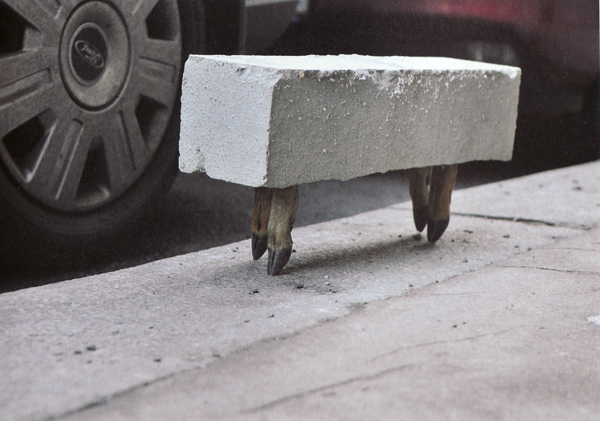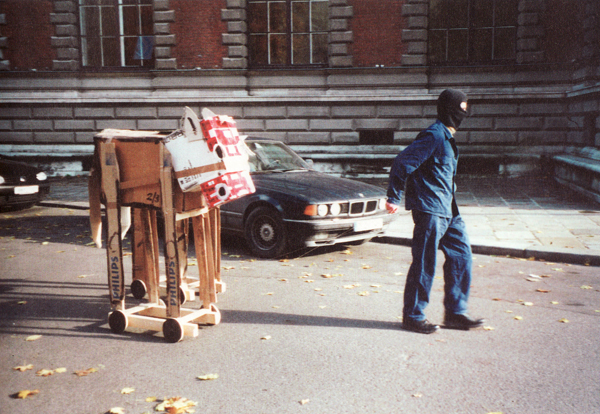christian eisenberger

Christian Eisenberger: Dachshund (Dackel); 2008, mixed media, courtesy of the artist

Christian Eisenberger: trojan (trojanisch); 2001, performance in Vienna, courtesy of the artist
“The cult around the person of Christian Eisenberger as an interventionist who acted anonymously in public space for years eventually lead to his public appearance as an artist whose works have also entered the gallery space although his artistic practice is still mainly directed at certain moments in public space. What is characteristic for Eisenberger’s approach is the use of everyday materials, mainly cardboard and carton. He often draws on found objects taken from public space in order to process them and return them to public space in the form of recycled objects. […] Questions as to the materials used are always context-related in Eisenberger’s work because his idea of art is not based on any pre-formulated mediality and can always be adapted to local conditions. In most of the cases the accumulation of found and then transformed material leads to exuberant growths or metastases as could be seen in the title of an installation in the Projektraum Viktor Bucher in Vienna in 2007. […] Eisenberger varies his actions depending on the context and environment he deliberately selects. Here the artist investigates, among other things, how corporeality as the most widespread tool of advertising in the mass media and at the same time most vulnerable level of sensitivity can be put to the test. […] The body as an architecturally pre-formulated composition of surfaces whose borders artists try to break up time and again also comes up in those figures made of brown duct tape that represent the artist’s body and have been shaped around his body. From time to time such figures can be found in public space too. Only lately Eisenberger has begun also to fill them with concrete thus returning to the classic sculptural idea of the body’s representation. The fragility or balance of physical and psychological aspects as units bringing about the subject are defined by questions pertaining to bondage, embalmment and the – animal or human – body’s shell and its vulnerability respectively. […] Eisenberger’s approach to space is characterized by a plethora of individual elements that more often than not culminate in a proliferation of materials. Tubular forms reminiscent of crutches or prostheses are often inserted in a given space as some kind of vertical and horizontal grid and cut up its structure. Here too brown duct tape serves as the central element that links the individual parts. No matter if a domestic environment during his hermitage in the church, as an extended work shop situation or fitting or extension of a gallery space, the tubular or boxlike cardboard ramifications always take on new dimensions, that refer to aspects of overpopulation and the consequent need for housing. Eisenberger’s interventions into different models of public social space are always conducted in the form of a guerrilla tactic where the artist acts as an anonymous person and leaves behind artistic traces of an ephemeral life span.”
– Excerpts from: Walter Seidl, “Guerilla Tactics and the Ephemeral Nature of Art – About Christian Eisenberger’s Work,” in Oxytocin Szintillation, Schlebrügge.Editor and Christian Eisenberger (eds.), Wien/Vienna 2009.
Christian Eisenberger's (*1978 in Graz) favors utensils are materials that can be found everywhere, such as cardboard and cellar tape. Nothing shall be in the way of an immediate art action. While he likes to liven his native Steiermark with so-called land art, the young artist makes use of the public space of the city for his always globally readable interventions. Like traces he leaves behind him cardboard pictures with portraits of public figures, or attracts attention as a clown with an explosive belt. In 1999 he studied painting at the Ortweinschule Graz. From 2000 on he continued his education at the University for Applied Art in Vienna, where he studied especially in the class of transmedia art of Brigitte Kowanz. In 2003 he took part in the workshop “Stone Age” with Jimmie Durham in Norway. In 2004 he participated in a symposium in Venice with Rirkrit Tiravanija. Eisenberger is the initiator and impresario of “K2, Kunsthalle Semriach.”